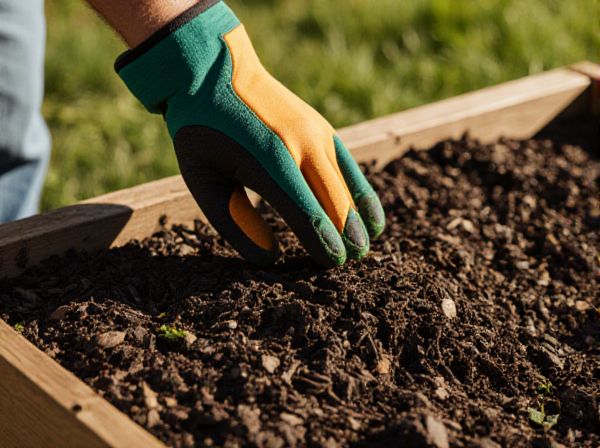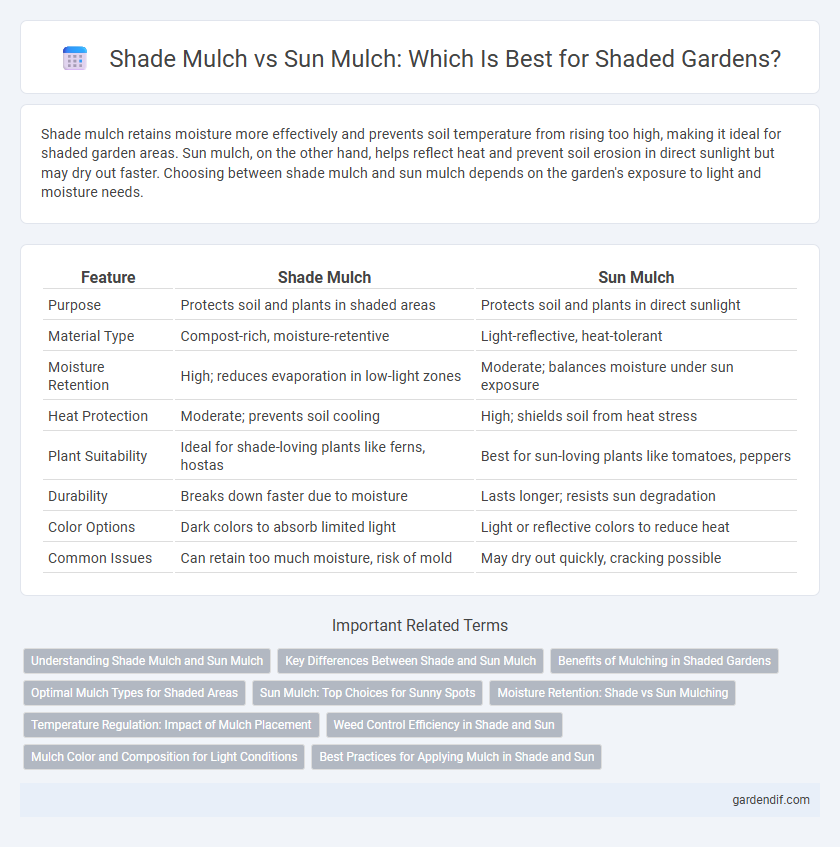
shade mulch vs sun mulch Illustration
Shade mulch retains moisture more effectively and prevents soil temperature from rising too high, making it ideal for shaded garden areas. Sun mulch, on the other hand, helps reflect heat and prevent soil erosion in direct sunlight but may dry out faster. Choosing between shade mulch and sun mulch depends on the garden's exposure to light and moisture needs.
Table of Comparison
| Feature | Shade Mulch | Sun Mulch |
|---|---|---|
| Purpose | Protects soil and plants in shaded areas | Protects soil and plants in direct sunlight |
| Material Type | Compost-rich, moisture-retentive | Light-reflective, heat-tolerant |
| Moisture Retention | High; reduces evaporation in low-light zones | Moderate; balances moisture under sun exposure |
| Heat Protection | Moderate; prevents soil cooling | High; shields soil from heat stress |
| Plant Suitability | Ideal for shade-loving plants like ferns, hostas | Best for sun-loving plants like tomatoes, peppers |
| Durability | Breaks down faster due to moisture | Lasts longer; resists sun degradation |
| Color Options | Dark colors to absorb limited light | Light or reflective colors to reduce heat |
| Common Issues | Can retain too much moisture, risk of mold | May dry out quickly, cracking possible |
Understanding Shade Mulch and Sun Mulch
Shade mulch consists of organic or inorganic materials designed to retain moisture and regulate soil temperature under low-light conditions, promoting plant health in shaded areas. Sun mulch, on the other hand, is tailored to withstand high temperatures and intense sunlight, often featuring reflective properties to reduce soil overheating and moisture evaporation. Choosing the appropriate mulch based on sunlight exposure enhances soil quality, conserves water, and supports optimal plant growth.
Key Differences Between Shade and Sun Mulch
Shade mulch retains moisture longer and cools the soil by protecting roots from direct sunlight, making it ideal for plants sensitive to heat stress. Sun mulch, on the other hand, absorbs and reflects more sunlight, helping to warm the soil and promote growth in heat-loving plants. The choice between shade and sun mulch depends on plant species, soil temperature preferences, and moisture retention needs.
Benefits of Mulching in Shaded Gardens
Mulching in shaded gardens improves soil moisture retention by reducing evaporation, which is crucial under limited sunlight conditions. Shade mulch enhances soil temperature regulation, promoting root health and reducing stress in shade-loving plants. This practice also suppresses weed growth, minimizing competition for resources in low-light environments.
Optimal Mulch Types for Shaded Areas
Organic mulches such as shredded bark, pine needles, and leaf mold are ideal for shaded areas because they retain moisture and slowly decompose to enrich soil without causing excessive heat. In contrast, sun mulch options like rubber or gravel tend to absorb and radiate heat, which can stress shade-loving plants. Choosing soft, moisture-retentive mulches helps maintain a cooler root environment essential for healthy growth in low-light conditions.
Sun Mulch: Top Choices for Sunny Spots
Sun mulch excels in hot, sunny spots by retaining soil moisture and reflecting excess heat to protect plants from sun damage. Popular options like straw, wood chips, and gravel effectively reduce evaporation and maintain cooler root zones under direct sunlight. These sun mulches also improve soil health by preventing erosion and promoting beneficial microbial activity in high-exposure areas.
Moisture Retention: Shade vs Sun Mulching
Shade mulch significantly improves moisture retention by reducing evaporation rates compared to sun mulch, which dries out faster under direct sunlight. Organic mulches like bark or leaf mold perform better in shaded areas, maintaining soil moisture for longer periods and benefiting plant health. In contrast, sun mulch requires more frequent watering to compensate for increased moisture loss caused by higher temperatures and direct exposure.
Temperature Regulation: Impact of Mulch Placement
Shade mulch significantly improves temperature regulation by maintaining cooler soil temperatures under shaded areas, reducing heat stress on plant roots. Sun mulch, exposed to direct sunlight, tends to absorb more heat, which can elevate soil temperatures and accelerate moisture evaporation. Strategic placement of mulch in shaded zones helps sustain optimal root zone conditions and conserves soil moisture effectively.
Weed Control Efficiency in Shade and Sun
Shade mulch effectively suppresses weed growth by maintaining higher soil moisture and cooler temperatures, which slow seed germination and weed proliferation. In contrast, sun mulch benefits from higher soil temperatures and UV exposure that degrade weed seeds more rapidly, enhancing weed control efficiency in sunlit areas. Selecting mulch type based on light exposure improves overall weed management and plant health.
Mulch Color and Composition for Light Conditions
Shade mulch typically features darker colors such as deep browns or blacks to absorb limited light and warm the soil, whereas sun mulch often uses lighter colors like straw or white to reflect sunlight and reduce heat stress. Composition varies with shade mulch favoring organic matter like shredded bark or leaves to retain moisture in low-light environments, while sun mulch employs inorganic materials such as gravel or light-colored wood chips to minimize evaporation under intense sunlight. Choosing the appropriate mulch color and composition enhances plant growth by optimizing temperature regulation and moisture retention in varying light conditions.
Best Practices for Applying Mulch in Shade and Sun
Apply mulch in shade areas with thinner layers of 2 to 3 inches to prevent excess moisture and fungal growth, favoring organic mulches like shredded bark or pine needles that improve soil aeration. In sun-exposed zones, thicker mulch layers of 3 to 4 inches effectively retain soil moisture and regulate temperature, with materials such as wood chips or straw offering optimal heat protection. Regular monitoring and timely replenishment of mulch ensure sustained benefits for plant health in both sun and shade environments.
shade mulch vs sun mulch Infographic

 gardendif.com
gardendif.com